
May 17, 2017
RCHS’s New Book Is Pages and Pages of Pure LA
Rios Clementi Hale Studios’ colorful book, “Not Neutral: For Every Place, Its Story,” catalogues the work of a firm that actually understands the color, diversity, and whimsy of LA.

The upcoming book Not Neutral: For Every Place Its Story, by Rios Clementi Hale Studios, is a completist’s catalogue. It explores the firm’s prolific forays into landscaping, interior design, and other ventures. It includes the many built, cancelled, and proposed buildings the firm has attempted over its 30 year history. But most importantly, the book firmly establishes how—in contrast to many veteran Los Angeles architecture firms (such as those helmed by Thom Mayne and Eric Owen Moss)—Rios Clementi Hale Studios (RCHS) actually understands the whimsical heart of LA.
Page after page, with the help of artful photos and thoughtful text, the book showcases a delightful quirkiness. Yes, it is written by the principals themselves, so they are essentially blowing their own horn—but they have plenty to toot about. The essays, rife with memories and details, provide a window into their design process, in which the particularities of each location determine the final product, and their philosophical approach, reflecting the diversity of L.A. and celebrating its multi-culti rhythms. It has become RCHS’s crusade to reverse the relentless march toward beige and make the world Not Neutral. But there are priorities. RCHS would always rather a building be livable than iconic.
This mission also allows RCHS to be one of the few progressive architecture firms still serious about the concept of fun. Of course, this playful instinct occasionally results in saccharine architecture. Their recent addition to the IAC Building on the Sunset Strip, a white gridded, Vegas-esque extrusion that pointlessly cantilevers into the street, does not “imbue a sense of wonder and otherworldliness” as the book suggests. Far from it. But this is the exception to the rule. Any office unafraid to paint the ground of a farmer’s market lime green, while still managing to make tactful additions to Los Angeles landmarks, deserves a round of applause.


Moreover, unlike some high profile architects who only pay lip service to sustainability and urban integration (I’m looking at you Hadid/Schumacher), Rios Clementi Hale clearly makes a sincere effort to produce accessible, responsible design. The scope of their brownfield and land redevelopment projects is truly impressive. And, regardless of the net worth of future tenants, there’s a sense of dignity, community, and context in every housing project they tackle. The firm’s work clearly lives up to the book’s provocative subtitle: For Every Place, Its Story. Nothing they do exists in a vacuum—a refreshing approach in the era of starchitecture.
Nevertheless, it’s the firm’s furniture that steals the show here. The book’s 13 chapters detail their near Eames-level of obsession in ergonomic detail, their sense of humor, and their dedication to a Southern Californian color palette. The rationale for selecting the hue of orange used in a chair’s highlights is reinforced by a meticulous color analysis of flora. Lime green bench tables and furniture at the Hollywood Bowl are specifically scaled so one can pour wine comfortably. The hot pink reclining benches that line Grand Park in downtown LA are designed to look as if they’re always “in bloom.”
In Not Neutral’s forward, journalist Frances Anderton admits that the firm has managed to have an immense influence on Los Angeles without establishing a discernible brand of architecture or design. RCHS’s disinterest in the distinct is proof of a mature design process. While the firm’s ethos has garnered them an exemplary professional reputation for bettering our city, it has unfortunately robbed them of public recognizability. This 612-page behemoth is a step toward correcting this and is more than worthy of your coffee table.
Recent Viewpoints
Viewpoints
Google’s Ivy Ross Makes Sense of Color









